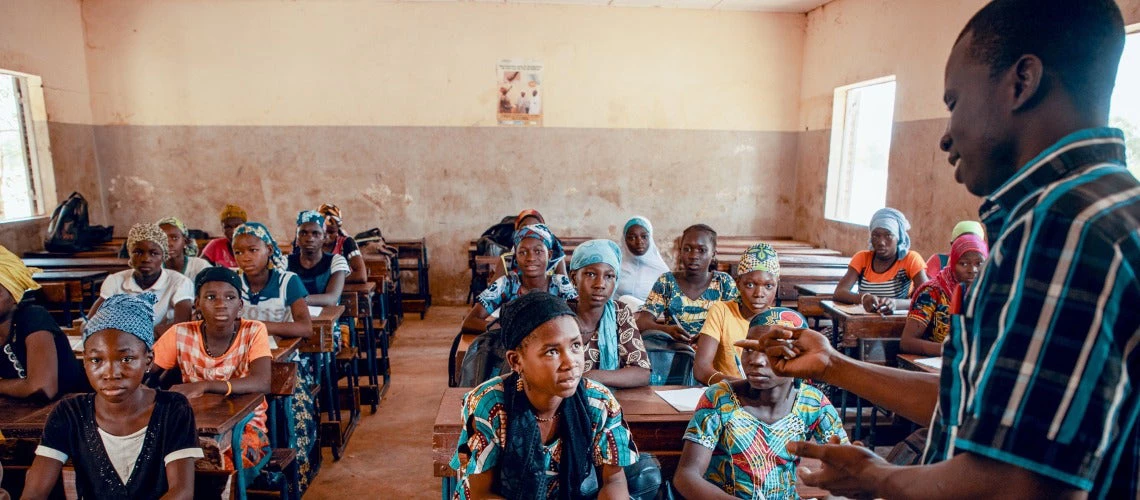 Education outcomes for girls have improved, but girls in high poverty and settings of fragility, conflict and violence still face challenges in attendance and enrollment. Copyright: Ollivier Girard/World Bank
Education outcomes for girls have improved, but girls in high poverty and settings of fragility, conflict and violence still face challenges in attendance and enrollment. Copyright: Ollivier Girard/World Bank
A decade after the World Development Report 2012: Gender Equality and Development we have seen encouraging improvement in education outcomes for girls. Primary school completion rates are almost equal between boys and girls, and there has been significant progress in secondary education enrollment rates.
Girls’ education matters, but our focus must evolve to meet new challenges.
First, girls in high poverty and settings of fragility, conflict and violence (FCV) still face challenges in attendance and enrollment. Learning remains a critical issue for both boys and girls alike.
Second, ensuring that girls access quality education is a central part of building and protecting human capital for themselves today, for their future economic prospects and for successive generations. Human capital promotion and protection are a key outcome of the proposed World Bank Group Gender Strategy 2024-30. In Achieving Gender Equality in Education: Examining Progress and Constraints, an underpinning for the new gender strategy, we take a close look at the latest research and findings on gender equality outcomes in education, as well as issues, evidence on promising solutions, operational good practices, and areas for future engagement.
We need multipronged approaches based on what works to close gaps in girls’ education
The benefits of girls’ education are clear, including across health, social and economic outcomes. And the evidence is decisive on many areas of what works to overcome barriers that girls face—for example, tackling obstacles of distance and cost through interventions including scholarships, stipends, and cash transfers.
At the same time, there are fewer studies in many areas such as the utility of social campaigns for boosting girls’ education enrollment; how gender-sensitive curricula, textbooks, and teaching can reduce bias and further girls’ achievement; and the impacts of school-based interventions for girls, such as separate toilets, school safety, and gender-based violence (GBV) reduction mechanisms. Studies are beginning to emerge in these areas, and more are needed.
This research informs policy approaches that target multiple barriers faced by girls, providing a strong base to continue to test, learn, adapt and expand on these approaches.
Schools are social incubators, playing a pivotal role in empowering girls and shaping norms
Research shows the clear impact of social norms on gender outcomes, including schooling and education outcomes. Importantly, we know that schools have the power to shape these norms and give both girls and boys the ability to positively transform their roles, behaviors and futures. We consider schools as “incubators” where students develop a view of their own potential and rights, and as critical to empowering all students.
One way we can bolster this link is through empowerment programs targeting adolescent girls. Evidence from Africa and South Asia has demonstrated the impressive impact of adolescent girls’ empowerment programs, for example from the World Bank’s Adolescent Girls Initiative. The World Bank is now supporting a “new generation” of projects in Angola, Tanzania, Nigeria, and Mozambique that build on lessons from previous efforts, including the Adolescent Girls Initiative and the Sahel Women's Empowerment and Demographics Project. These approaches target sexual and reproductive health and rights, GBV, and women’s economic participation. For example, the Sudan Basic Education Support Project includes activities to train schools and their surrounding communities on GBV reduction.
We must bridge the broken link to employment
There are clear disparities in women and men’s labor market outcomes, and education has a pivotal role in this tackling this. We see an education-employment paradox, in which high learning outcomes are not translating to labor market outcomes for girls. On the flip side, boys often face the challenge of underperformance in schools, but have higher labor market outcomes.
As more and more girls are accessing education, we need to look at how we can help them translate education into successful outcomes. A striking 1 in 4 girls aged 15–19 globally are not in education, employment or training (NEET), compared to 1 in 10 boys. That is a quarter of girls who are not able to engage fully in developing higher order skills or realizing the returns to their education in the workforce. In Latin America, a recent World Bank study finds the share of girls who are NEETs is significantly higher than among young men, and can be as high as 46%. They find that the challenges girls face are often different than for boys and are often strongly impacted by gender norms.
Access to reproductive health services among adolescents, encouraging girls’ agency and aspirations including for employment in higher paying occupations, and using proven approaches such as mentoring to address occupational segregation are all needed.
How can education programs contribute to address this problem? The Economic Acceleration and Resilience for NEET Project in Bangladesh, for example, is working with girls and their family members to increase access to education and skills training and promote the employability of the NEET youth, especially girls and women. The project also promotes equal access and opportunities for other subgroups, including persons with disability, transgender, and ethnic minorities.
Girls’ education is essential for sustainable, resilient, and inclusive development
This year, the World Bank has created a new vision for an evolving mission, one that emphasizes addressing global challenges on a livable planet. This cannot be achieved without gender equality in education.
Girls’ education is highly vulnerable to disruption from fragility and crises including conflict and climate change effects. Notably, girls in FCV situations are some of the most marginalized. At the same time, educating girls strengthens countries’ resilience to shocks. Girls and women also have a pivotal role in addressing climate change, whether at the household level, in the community or in the labor market. One way to support this is through STEM investments, which empower girls to shape their societies and environments as scientists, innovators and active citizens. In Tanzania, for example, the Higher Education for Economic Transformation Project is making a strong, multi-pronged push to promote more girls and young women in STEM subjects.
Where do we go from here?
It is increasingly pressing to support girls’ abilities to thrive in an ever-changing world and to be able to tackle global challenges. These ideas and more are detailed in our policy note. You can download it here, and share your feedback on the WBG gender strategy to help us shape the path ahead.
To receive weekly articles, sign-up here




Join the Conversation